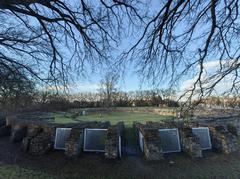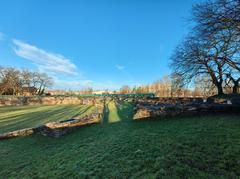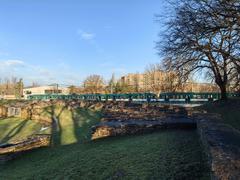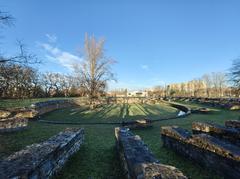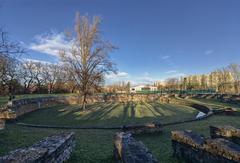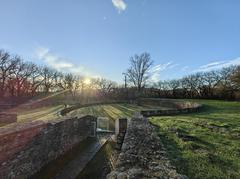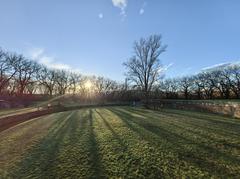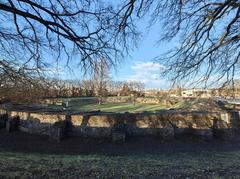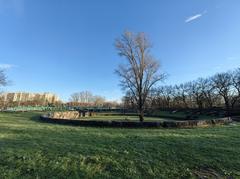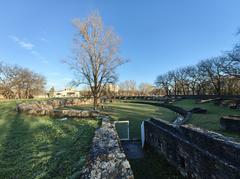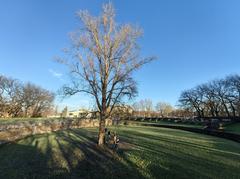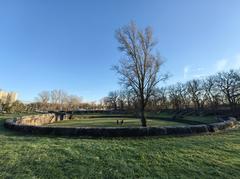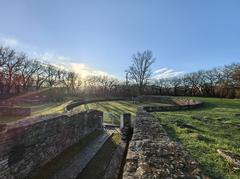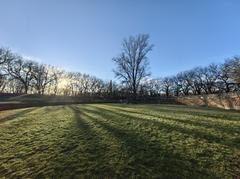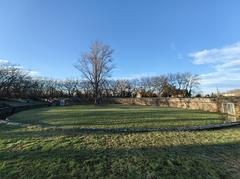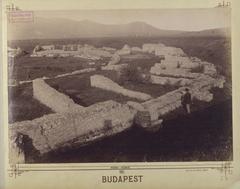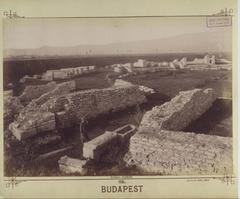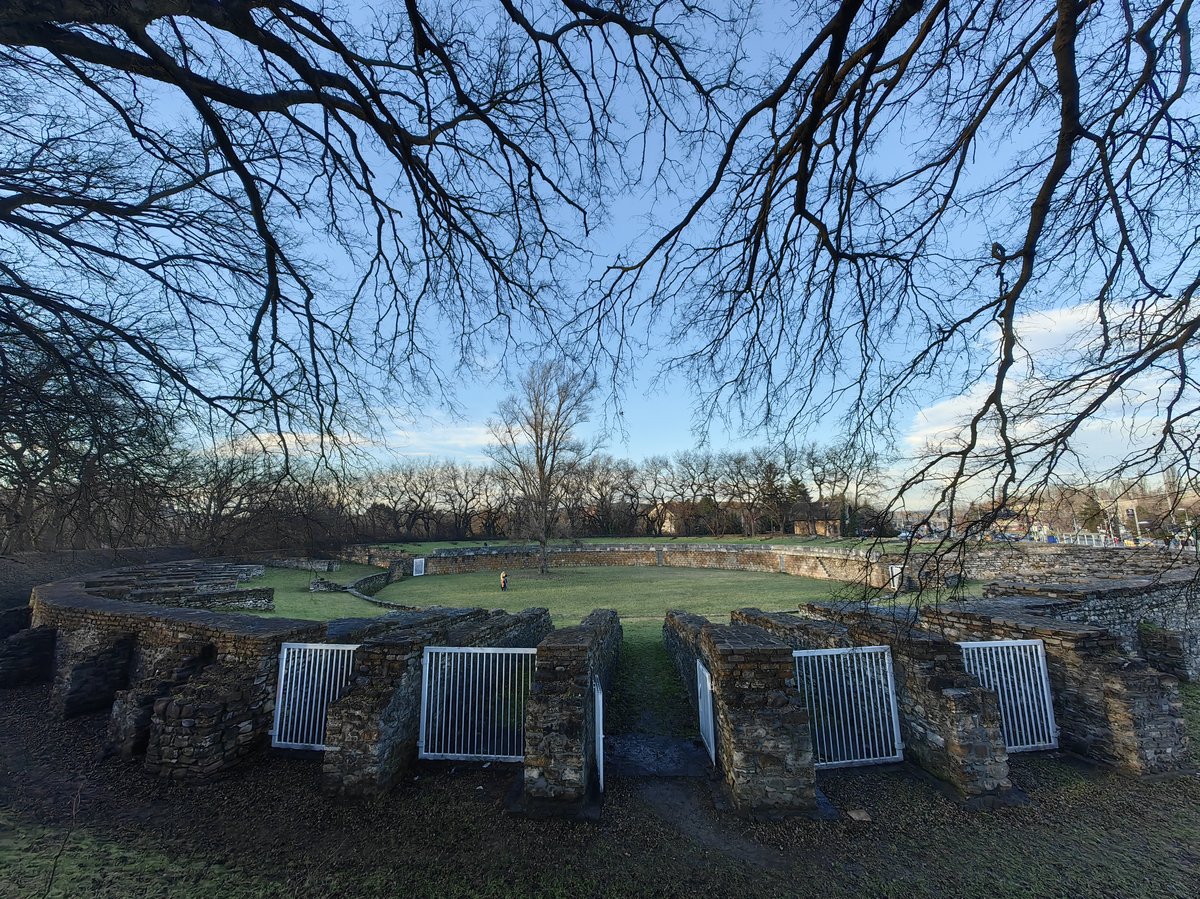
Aquincum Civil Amphitheatre Budapest: Comprehensive Visiting Guide
Date: 15/06/2025
Introduction
The Aquincum Civil Amphitheatre, located in Budapest’s historic Óbuda district, is one of Central Europe’s most evocative Roman ruins. As a vital part of Aquincum—the capital of the Roman province of Pannonia Inferior—the amphitheatre reflects the urban sophistication and cultural vibrancy of Rome’s northern frontier. This guide explores the amphitheatre’s history, architecture, cultural significance, and provides essential information for visitors, including opening hours, ticketing, accessibility, transport, and nearby attractions. Whether you’re a passionate historian or a casual traveler, the Aquincum Civil Amphitheatre offers a unique journey into Budapest’s ancient past (Britannica; Archaeology Magazine; Lonely Planet).
Roman Origins and Urban Development
Before Roman occupation, the area was settled by the Celtic Eravisci, known as “Ak-ink” for its rich thermal springs. The Romans established a fort here in the 1st century CE, recognizing the strategic and logistical advantages provided by the Danube and fertile plains. Under Emperor Trajan, Aquincum became the capital of Lower Pannonia in 106 CE, and later, under Diocletian, the capital of Pannonia Valeria. By its peak, Aquincum boasted a population of 30,000–50,000, with advanced infrastructure, public baths, aqueducts, and two amphitheatres (Britannica; Archaeology Magazine).
Architectural Design and Features
Layout and Construction
Constructed between 250 and 300 CE, the Aquincum Civil Amphitheatre was designed for the city’s civilian population, distinguishing it from the larger military amphitheatre nearby. Its elliptical arena measures approximately 86 by 75 meters and could accommodate 6,000–7,000 spectators (Spotting History; ShunCulture). Built from local stone and employing Roman techniques such as opus caementicium (Roman concrete), the amphitheatre features tiered seating with clear social stratification—elite citizens sat closest to the action, while the general public occupied upper tiers (Wikipedia).
Key Elements
- Arena and Subterranean Spaces: The sand-covered arena hosted gladiatorial games, animal hunts, and other spectacles. Service corridors and storage rooms beneath supported logistics, though fewer underground chambers remain compared to Rome’s Colosseum (Ancient Origins).
- Entrances: The amphitheatre had at least four main gates, with the best-preserved being the south gate, featuring an inscription dedicated to Nemesis, the goddess of justice and retribution (Wikipedia).
- Seating (Cavea): Divided by staircases and baltei (low walls), the seating layout mirrored Roman social hierarchy and ensured efficient crowd movement.
- Decor and Inscriptions: While much ornamentation has been lost, fragments of columns, reliefs, and the notable Nemesis inscription remain, highlighting the amphitheatre’s dual role as an entertainment venue and religious site.
Social and Cultural Significance
The amphitheatre was central to Roman Aquincum’s social life, hosting events that reinforced civic unity and imperial authority. Gladiatorial contests, animal hunts, and public ceremonies fostered social cohesion and reminded spectators of Rome’s power. The presence of Nemesis’s dedication underscores the intertwining of religion, justice, and public spectacle (Budapest Local; Spotting History).
Decline, Abandonment, and Preservation
Aquincum suffered during the Marcomannic wars of the 2nd century but rebounded until the late 3rd century, when repeated invasions led to the town’s abandonment. The military fortress remained until the 5th century, after which the site was deserted. Notably, medieval development did not extensively overbuild the civil town, allowing significant Roman remains to survive. Archaeological excavations, begun in the late 19th century, continue to reveal new insights into Roman Budapest (Britannica; Archaeology Magazine; Budapest.net).
Visiting Information
Location and Access
- Address: Római tér 2, 1031 Budapest, Óbuda-Békásmegyer (District III).
- Public Transport: H5 suburban railway (HÉV) to Aquincum station (8–10 minute walk); buses 34, 106, and 134 stop nearby (Your City Budapest; Cestee).
- By Car: Limited on-street parking; public transport recommended due to congestion.
Opening Hours
- Civil Amphitheatre: Open-air and accessible year-round during daylight hours.
- Aquincum Museum & Archaeological Park:
- April 1 – October 31: Tues–Sun, 9:00–18:00 (last entry 17:30)
- November 1 – March 31: Tues–Sun, 10:00–16:00 (last entry 15:30)
- Closed Mondays
Tickets and Admission
- Civil Amphitheatre: Free to enter; no ticket required.
- Museum & Archaeological Park: 2,200 HUF (~€6) for adults; discounts for students, seniors, groups, and Budapest Card holders.
- Guided Tours: Available at the museum, including English-language options. Advance booking is recommended for groups (Cestee).
Accessibility
- The amphitheatre features grassy, uneven terrain and lacks paved paths; wheelchair access is limited.
- Restrooms, café, and gift shop are available at the museum (8–10 minute walk away).
- Assistance can be requested for visitors with mobility challenges.
Facilities
- No restrooms or food vendors at the amphitheatre.
- Facilities, information, and guided tours are provided at the Aquincum Museum.
Practical Tips for Visitors
- Best Time to Visit: Spring and autumn offer mild weather and fewer crowds; check for special events or reenactments.
- Footwear: Wear comfortable, sturdy shoes due to uneven surfaces.
- Weather: Bring sun protection and water, especially in summer.
- Photography: Permitted; best light is in the early morning or late afternoon. Drone use requires special permission.
- Preservation: Do not climb on ancient stones; help protect the ruins.
Nearby Attractions
- Aquincum Museum and Archaeological Park: Extensive Roman ruins, interactive exhibits, and educational resources (Just Budapest).
- Roman Military Amphitheatre: Larger and well-preserved, free to visit.
- Római-part: Riverside promenade with cafés, about a 20-minute walk.
- Hercules Villa: Roman villa with mosaic floors.
- Óbudai Cemetery: Historic cemetery with notable burials.
- Old Óbuda: Charming historic district with shops and restaurants.
Visuals and Digital Resources
- Virtual Tours: Available via the official Aquincum Museum website.
- Maps and Signage: Provided at the museum and on-site.
- Images: Use high-quality photos with descriptive alt text like “Exterior view of Aquincum Civil Amphitheatre, Budapest” for accessibility and SEO.
Frequently Asked Questions (FAQ)
Q: Is the Aquincum Civil Amphitheatre free to visit?
A: Yes, it is open-air and free of charge.
Q: Are there guided tours?
A: Guided tours are available at the Aquincum Museum and Archaeological Park.
Q: How accessible is the site?
A: The terrain is uneven; wheelchair access is limited, but assistance is possible.
Q: Are there restrooms or food vendors at the amphitheatre?
A: No; these facilities are available at the Aquincum Museum a short walk away.
Q: Can tickets be purchased online?
A: Museum tickets can be purchased on-site; online pre-purchase is optional.
Q: What is the best way to reach the amphitheatre?
A: Public transport (H5 suburban railway or city buses) is recommended.
Summary and Recommendations
The Aquincum Civil Amphitheatre stands as a testament to Roman engineering, civic life, and Budapest’s enduring historical legacy. With free access, proximity to the Aquincum Museum, and a wealth of nearby Roman sites, it is a rewarding destination for all visitors. Plan to combine your amphitheatre visit with the museum and archaeological park for a comprehensive experience. Download the Audiala app for audio guides and follow our channels for updates on Budapest’s historical offerings.
Additional Resources
- Official Aquincum Museum Website
- Just Budapest: Aquincum Museum Guide
- Travel Guide Budapest: Amphitheatre in the Civil Town
- Trek Zone: Aquincum Civil Amphitheatre
- Hikersbay: Aquincum Civil Amphitheatre
- Britannica
- Archaeology Magazine
- Budapest Local
- Spotting History
- Wikipedia
- Cestee
- HeritageDaily
- Lonely Planet
- Ancient Origins
- ShunCulture
- Your City Budapest
- Budapest.net
